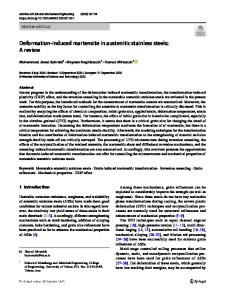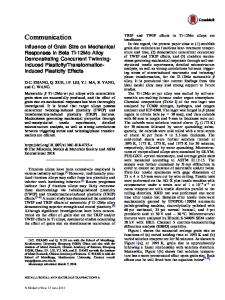Investigation of Deformation Mechanisms in Deep-Drawn and Tensile-Strained Austenitic Mn-Based Twinning Induced Plastici
- PDF / 531,966 Bytes
- 8 Pages / 593.972 x 792 pts Page_size
- 104 Downloads / 291 Views
ODUCTION
IN order to improve safety and fuel economy, the use of advanced high strength steels in the automotive industry has increased significantly in the last decade. One of the latest developments is austenitic Mn-based twinning induced plasticity (TWIP) steels, which combine high strength with high ductility. These superior mechanical properties are a result of deformation mechanisms involving twinning or plasticity-induced transformation[1–6] related to the austenite (c) stability. The deformation mechanisms in these Mn-based TWIP steels have been most intensively investigated for tensile straining,[3–6] leaving the role of large strain on the twinning or transformation-induced plastic deformation mechanism less exposed.[7] In the present work, the effect of both deep drawing and tensile straining on the defect and microstructure evolution in Mn-based TWIP steels was experimentally investigated using magnetic measurements, X-ray diffraction (XRD), and positron annihilation. The strain evolution during deep drawing was simulated by means of finite element methods. II.
EXPERIMENTAL
The examined material was a Mn-based TWIP steel grade that is austenitic at room temperature. Table I shows the chemical composition of this steel. The stacking fault energy (SFE) amounts to 52 mJ/m2, based on the R.T. VAN TOL, Principal Researcher, is with Tata Steel Research Development & Technology, 1970 CA IJmuiden, The Netherlands. Contact e-mail: [email protected] L. ZHAO, Scientific Researcher, is with the Materials Innovation Institute, 2628 CD Delft, The Netherlands, and is also with the Department of Materials Science and Engineering, Delft University of Technology, 2628 CD Delft, The Netherlands. H. SCHUT, Scientific Researcher, is with the Faculty of Applied Sciences, Delft University of Technology. J. SIETSMA, Professor, is with the Department of Materials Science and Engineering, Delft University of Technology. Manuscript submitted August 31, 2011. Article published online May 1, 2012 3070—VOLUME 43A, SEPTEMBER 2012
thermodynamic approach proposed by Bleck et al.,[8] with empirical coefficients for Si (–7 mJ/m2 per wt pct Si)[9] and Al (+10 mJ/m2 per wt pct Al).[10] Note that this calculated value is estimated to be accurate within ±10 mJ/m2. The material was cold rolled to a thickness of 1.7 mm and then recrystallized. Table I also shows the mechanical properties after recrystallization. The cold-rolled and recrystallized sheets were cut into round blanks with a diameter of 102.5 mm using water jet cutting technology. The blanks were formed into cups by deep drawing on an Erichsen press (Tata Steel Research Development & Technology, IJmuiden, The Netherlands) with a ratio of blank diameter to punch diameter of 2.05. Table II shows the other deep-drawing parameters. Standard A80 tensile samples, according to the Euro-norm, were strained up to 10, 20, 30, and 40 pct using a Zwick tensile tester (Tata Steel Research Development & Technology, IJmuiden, The Netherlands). Scanning electron microscopy (SEM) was performed on
Data Loading...











